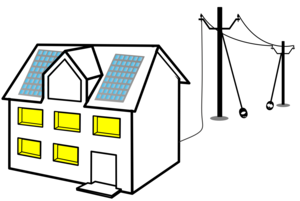Today, grid tied systems are the most common type of photovoltaic systems. A grid tied system will allow you to save more money with solar panels through better efficiency rates, net metering, plus lower equipment and installation costs. Often, solar panels will generate more electricity than what one is capable of consuming. With net metering, the users can put this excess electricity onto the utility grid instead of storing it themseleves with batteries.
Net metering plays an important role in how solar power is incentivized. Without it, the solar systems would be much less feasible from a financial point of view. The utility grid acts as a virtual battery, without the need for maintenance or replacements and with much better efficency rates. Grid tied systems do not provide protection from power cuts. When the electrical grid fails, grid tied systems will not continue to operate. This allows utility employees to fix the power lines safely without wasting time indentifying solar energy systems that are still feeding electricity into the power lines.


Features
→ Large Utility Scale Model
→ Night Power Drawn from Grid
→ Surplus Supply to Grid

Components
→ Solar Panels
→ Grid-Tie Inverter
→ Meters (For Net Metering Policy)
→ Grid

Benefits
→ Low Electricity Bills
→ Faster ROI
→ Better Savings

Applicability
→ Best suited for Urban Areas with Strong Grid Connectivity